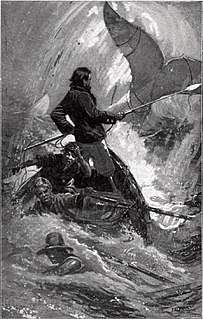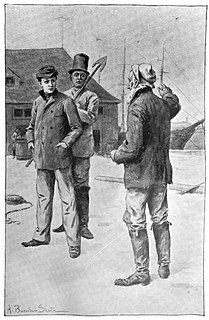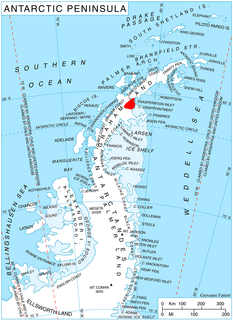 W
WMoby-Dick; or, The Whale is an 1851 novel by American writer Herman Melville. The book is the sailor Ishmael's narrative of the obsessive quest of Ahab, captain of the whaling ship Pequod, for revenge on Moby Dick, the giant white sperm whale that on the ship's previous voyage bit off Ahab's leg at the knee. A contribution to the literature of the American Renaissance, Moby-Dick was published to mixed reviews, was a commercial failure, and was out of print at the time of the author's death in 1891. Its reputation as a "Great American Novel" was established only in the 20th century, after the centennial of its author's birth. William Faulkner said he wished he had written the book himself, and D. H. Lawrence called it "one of the strangest and most wonderful books in the world" and "the greatest book of the sea ever written". Its opening sentence, "Call me Ishmael", is among world literature's most famous.
 W
WCaptain Ahab is a fictional character and one of the main protagonists in Herman Melville's Moby-Dick (1851). He is the monomaniacal captain of the whaling ship Pequod. On a previous voyage, the white whale Moby Dick bit off Ahab's leg, and he now wears a prosthetic leg made out of whalebone. The whaling voyage of the Pequod ends up as a hunt for revenge on the whale, as Ahab forces the crew members to support his fanatical mission. When Moby Dick is finally sighted, Ahab's hatred robs him of all caution, and the whale drags Ahab to his death beneath the sea.
 W
WMount Ahab is a conspicuous mountain 925 metres (3,035 ft) high that rises between the lower ends of Mapple Glacier and Melville Glacier on the east coast of Graham Land. The mountain was roughly surveyed in 1947 by Falkland Islands Dependencies Survey and was resurveyed in 1955. The name was repositioned following a survey by the British Antarctic Survey in 1962. It was named by the United Kingdom Antarctic Place-Names Committee after Captain Ahab of the whaler Pequod - the central character in Herman Melville's Moby-Dick.
 W
WIshmael is a character in Herman Melville's Moby-Dick (1851), which opens with the line, "Call me Ishmael." He is the first person narrator in much of the book. Ishmael plays a minor role in the plot, however, and early critics of Moby-Dick assumed that Captain Ahab is the protagonist. Many either confused Ishmael with Melville or overlooked the role he played. Later critics distinguished Ishmael from Melville, and some saw his mystic and speculative consciousness as the novel's central force rather than Captain Ahab's monomaniacal force of will.
 W
WOwen Chase was first mate of the whaler Essex, which a sperm whale rammed and sank on 20 November 1820. Chase wrote about the incident in Narrative of the Most Extraordinary and Distressing Shipwreck of the Whale-Ship Essex. This book, published in 1821, would inspire Herman Melville to write Moby-Dick. Chase was born in Nantucket, Massachusetts, the son of Phebe (Meader) and Judah Chase.
 W
WGreen Shadows, White Whale is a 1992 novel by Ray Bradbury. It gives a fictionalized account of his journey to Ireland in 1953-1954 to write a screen adaptation of the novel Moby-Dick with director John Huston. Bradbury has said he wrote it after reading actress Katharine Hepburn's account of filming The African Queen with Huston in Africa. The title itself is a play on Peter Viertel's novel White Hunter, Black Heart, which is also about Huston.
 W
WIshmael is a character in Herman Melville's Moby-Dick (1851), which opens with the line, "Call me Ishmael." He is the first person narrator in much of the book. Ishmael plays a minor role in the plot, however, and early critics of Moby-Dick assumed that Captain Ahab is the protagonist. Many either confused Ishmael with Melville or overlooked the role he played. Later critics distinguished Ishmael from Melville, and some saw his mystic and speculative consciousness as the novel's central force rather than Captain Ahab's monomaniacal force of will.
 W
WMapple Glacier is a narrow glacier 15 nautical miles (28 km) long, flowing eastward between Arkovna Ridge and Stevrek Ridge in the Aristotle Mountains of Antarctica to enter Sexaginta Prista Bay on the east side of Graham Land. It lies 2 nautical miles (4 km) north of Melville Glacier and is separated from it by a line of small peaks. The glacier was surveyed by the Falkland Islands Dependencies Survey in 1961, and was named by the UK Antarctic Place-Names Committee after Father Mapple, the whalemen's Nantucket priest in Herman Melville's Moby-Dick.
 W
WHerman Melville was an American novelist, short story writer, and poet of the American Renaissance period. Among his best-known works are Moby-Dick (1851); Typee (1846), a romanticized account of his experiences in Polynesia; and Billy Budd, Sailor, a posthumously published novella. Although his reputation was not high at the time of his death, the centennial of his birth in 1919 was the starting point of a Melville revival, and Moby-Dick grew to be considered one of the great American novels.
 W
WMoby Dick is a sperm whale who is the main antagonist in Herman Melville's 1851 novel of the same name. Melville based the whale partially on a real albino whale of that period called Mocha Dick.
 W
WKnown in the numismatic world as a "Moby Dick Coin", the Ecuadorian 8 Escudos doubloon, minted in Quito, Ecuador, between 1838 and 1843, is the one ounce of gold "sixteen dollar piece" Captain Ahab nails to the mast of the Pequod, promising it to the first man who "raises" Moby-Dick. The coin is first mentioned in Herman Melville's 1851 novel Moby-Dick, in Chapter 36 "The Quarter Deck" and later at length in Chapter 99 "The Doubloon". It is often mistaken as a Spanish doubloon, but this coin was not struck by the Spanish crown or endorsed by the Spanish government. The Moby Dick coin was minted in the Republic of Ecuador, at the Quito mint, many years after its independence from Spain.Now those noble golden coins of South America are as medals of the sun and tropic token-pieces. Here palms, alpacas, and volcanoes; sun’s disks and stars, ecliptics, horns-of-plenty, and rich banners waving, are in luxuriant profusion stamped; so that the precious gold seems almost to derive an added preciousness and enhancing glories, by passing through those fancy mints, so Spanishly poetic. It so chanced that the doubloon of the Pequod was a most wealthy example of these things. On its round border it bore the letters, Republica del Ecuador: Quito. So this bright coin came from a country planted in the middle of the world, and beneath the great equator, and named after it; and it had been cast midway up the Andes, in the unwaning clime that knows no autumn. Zoned by those letters you saw the likeness of three Andes’ summits; from one a flame; a tower on another; on the third a crowing cock; while arching over all was a segment of the partitioned zodiac, the signs all marked with their usual cabalistics, and the keystone sun entering the equinoctial point at Libra.
 W
WMocha Dick was a male sperm whale that lived in the Pacific Ocean in the early 19th century, usually encountered in the waters near Mocha Island, off the central coast of Chile. American explorer and author Jeremiah N. Reynolds published his account, "Mocha Dick: Or The White Whale of the Pacific: A Leaf from a Manuscript Journal" in 1839 in The Knickerbocker. Mocha Dick was an albino and partially inspired Herman Melville's 1851 novel Moby-Dick.
 W
WPequod is a fictional 19th-century Nantucket whaling ship that appears in the 1851 novel Moby-Dick by American author Herman Melville. Pequod and her crew, commanded by Captain Ahab, are central to the story, which, after the initial chapters, takes place almost entirely aboard the ship during a three-year whaling expedition in the Atlantic, Indian and South Pacific oceans. Most of the characters in the novel are part of Pequod's crew, including the narrator Ishmael.
 W
WPequod Glacier is a glacier over 15 nautical miles (28 km) long, draining eastwards between Parlichev Ridge to the north, and Taridin Ridge and Krupen Ridge to the south, and flowing into Exasperation Inlet on the east coast of Graham Land. It lies parallel and just south of Melville Glacier. The lower part of the glacier was surveyed by Falkland Islands Dependencies Survey (FIDS) in 1947 and the upper reaches were surveyed in 1955. Named by United Kingdom Antarctic Place-Names Committee (UK-APC) after the whaling ship Pequod in Herman Melville's Moby-Dick.
 W
WQueequeg is a character in the 1851 novel Moby-Dick by American author Herman Melville. The son of a South Sea chieftain who left home to explore the world, Queequeg is the first principal character encountered by the narrator, Ishmael. The quick friendship and relationship of equality between the tattooed cannibal and the white sailor show Melville's basic theme of shipboard democracy as well as his fondness for Polynesians.
 W
WThe Seamen's Bethel is a chapel in New Bedford, Massachusetts, United States, located at 15 Johnny Cake Hill.
 W
WTashtego Point is a rocky point marking the east end of the ridge at the south side of Stubb Glacier, on the east coast of Graham Land. Surveyed and photographed by the Falkland Islands Dependencies Survey (FIDS) in 1947. Named by the United Kingdom Antarctic Place-Names Committee (UK-APC) after Tashtego, the Wampanoag harpooner on the Pequod in Herman Melville's Moby-Dick.